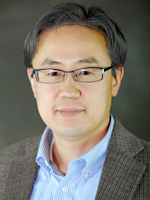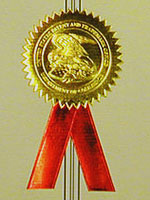Recent News
CHTM Joins NSF's NQVL Pilot Projects
August 9, 2024
OSE PHD, Dr. Xuefeng Li - Wins The Outstanding Interdisciplinary Graduate Programs Award
May 10, 2024
Dr. Ali Rastegari - 2024 OSE Best Dissertation Award Winner
May 10, 2024
2024 OSE Spring and Summer Graduates
May 10, 2024
News Archives
U.S. Patent issued to Han et al. for patterning of germanium quantum dots
June 26, 2017 - CHTM

Sang M. Han
The U.S. Patent & Trademark Office (USPTO) issued U.S. Patent No. 9,666,431, titled “Large-scale patterning of germanium quantum dots by stress transfer," to Han et al. on May 30, 2017. Sang M. Han is a Professor with The University of New Mexico Departments of Chemical & Biological Engineering and Electrical & Computer Engineering; Associate Chair of Chemical & Biological Engineering; and the Director of Nanoscience & Microsystems Engineering; as well as a Center for High Technology Materials (CHTM) faculty member.
Talid R. Sinno, Professor with the University of Pennsylvania School of Engineering and Applied Science, is named as co-inventor.
Abstract
Provided is a method for forming a two-dimensional array of semiconductor quantum confined structures. The method includes providing a layer that has first atoms and second atoms, the first atoms having a different size than the second atoms; providing an indenter template that includes at least one indenter structure extending from a surface of the indenter template; contacting the layer and the at least one indenter structure together with a pressure sufficient to generate an elastic deformation in the layer but without generating plastic deformation of the layer; annealing the layer. The contacting of the layer and the at least one indenter structure includes forming at least one quantum confined structure in the layer.

The disclosure is generally directed to a method of making quantum confined structures, for example, nanostructures, such as quantum wells and/or highly ordered two-dimensional arrays of quantum dots (QDs).
Background (excerpt)
Nucleation and aggregation in atomic systems offer tremendous possibilities for making structures at the nanoscale that may be useful in a wide range of technologies, including nano and molecular electronics, high-density patterned media for data storage, optoelectronics, and nanosensor arrays. Examples of self assembly in atomic systems are ubiquitous in nature and technological applications and include precipitation of various phases in multi-component metallic alloys and island formation on crystalline semiconductor substrates. There has been much interest in utilizing the self-driving nature of nucleation and growth to produce nanostructures with precisely tailored size and/or spatial distributions.
The growth of highly-ordered two-dimensional arrays of semiconductor quantum dots lends itself to a variety of technologically important applications, ranging from sensors, to data storage, to quantum computing. Finding a viable, cost-effective path for manufacturing ultra-high density arrays of uniform semiconductor quantum dots (with quantum confinement properties) on semiconductor substrates would be desirable.
Principal investigator
Sang M. Han is a recipient of an STC.UNM Creative Award in 2009, 2010, 2011, 2012, and 2013, a UNM Junior Faculty Research Excellence Award in 2005, and a National Science Foundation Early Faculty CAREER Award in 2001. He has 45 publications in peer-reviewed journals and over 140 invited/contributed papers at academic institutions and conferences. Han has nine issued U.S. patents.
Han's current research topics include (1) selective growth of Ge quantum structures and high-quality heteroepitaxial films on Si; (2) III-V integration on engineered Ge-on-Si virtual substrates for photovoltaic, electronic, and sensor applications; (3) hybrid micro/nanofluidic systems for advanced bioseparation and analysis; (4) synthetic modification of semiconductor surfaces; and (5) nanocrystal synthesis and surface functionalization for nonlinear optical and biological applications.


